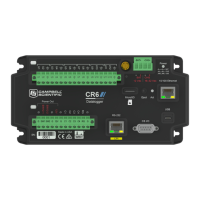10. Information tables and
settings (advanced)
Information tables and settings consist of fields, settings, and system information essential to
setup, programming, and debugging of many advanced CR6 systems. In many cases, the info
tables and settings keyword can be used to pull that field into a running CRBasic program. There
are several locations where this system information and settings are stored or changed:
l Status table: The Status table is an automatically created data table. View the Status table
by connecting the data logger to your computer (see Making the software connection (p.
43) for more information) Station Status , then clicking the Status Table tab.
l DataTableInfo table: The DataTableInfo table is automatically created when a program
produces other data tables. View the DataTableInfo table by connecting the data logger to
your computer (see Making the software connection (p. 43) for more information).
o
PC200W and PC400 users, click the Monitor Data tab and add the DataTableInfo to
display it.
o
LoggerNet users, select DataTableInfo from the Table Monitor list.
l Settings: Settings can be accessed from the LoggerNet Connect Screen Datalogger >
Settings Editor, or using Device Configuration Utility Settings Editor tab. Clicking on a
setting in Device Configuration Utility also provides information about that setting.
l Terminal Mode: A list of setting field names is also available from the data logger terminal
mode (from Device Configuration Utility, click the Terminal tab) using command "F".
l Status, DataTableInfo and Settings values may be accessed programmatically using
Tablename.Fieldname syntax. For example: Variable =
Settings.Fieldname. For more information
see:https://www.campbellsci.com/blog/programmatically-access-stored-data-values.
Communications and processor bandwidth are consumed when generating the Status and other
information tables. If data logger is very tight on processing time, as may occur in very fast, long,
or complex operations, retrieving these tables repeatedly may cause skipped scans.
Settings that affect memory usage force the data logger program to recompile, which may cause
loss of data. Before changing settings, it is a good practice to collect your data (see Collecting
data (p. 49) for more information). Examples of settings that force the data logger program to
recompile:
10. Information tables and settings (advanced) 163

